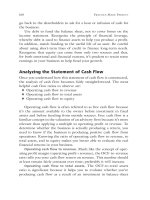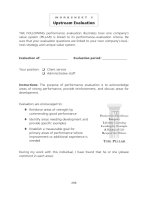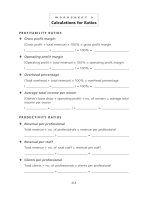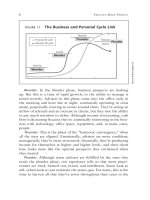practice makes perfect spanish vocabulary
Bạn đang xem bản rút gọn của tài liệu. Xem và tải ngay bản đầy đủ của tài liệu tại đây (3.03 MB, 450 trang )
Spanish
Vocabulary
PRACTICE
MAKES
PERFECT
Dorothy Richmond
New York Chicago San Francisco Lisbon London Madrid Mexico City
Milan New Delhi San Juan Seoul Singapore Sydney Toronto
Copyright © 2007 by The McGraw-Hill Companies, Inc. All rights reserved. Manufactured in the United States of America. Except as permitted under the United States
Copyright Act of 1976, no part of this publication may be reproduced or distributed in any form or by any means, or stored in a database or retrieval system, without the
prior written permission of the publisher.
0-07-151062-1
The material in this eBook also appears in the print version of this title: 0-07-145806-9.
All trademarks are trademarks of their respective owners. Rather than put a trademark symbol after every occurrence of a trademarked name, we use names in an editori-
al fashion only, and to the benefit of the trademark owner, with no intention of infringement of the trademark. Where such designations appear in this book, they have been
printed with initial caps.
McGraw-Hill eBooks are available at special quantity discounts to use as premiums and sales promotions, or for use in corporate training programs. For more information,
please contact George Hoare, Special Sales, at or (212) 904-4069.
TERMS OF USE
This is a copyrighted work and The McGraw-Hill Companies, Inc. (“McGraw-Hill”) and its licensors reserve all rights in and to the work. Use of this work is subject to
these terms. Except as permitted under the Copyright Act of 1976 and the right to store and retrieve one copy of the work, you may not decompile, disassemble, reverse
engineer, reproduce, modify, create derivative works based upon, transmit, distribute, disseminate, sell, publish or sublicense the work or any part of it without McGraw-
Hill’s prior consent. You may use the work for your own noncommercial and personal use; any other use of the work is strictly prohibited. Your right to use the work may
be terminated if you fail to comply with these terms.
THE WORK IS PROVIDED “AS IS.” McGRAW-HILL AND ITS LICENSORS MAKE NO GUARANTEES OR WARRANTIES AS TO THE ACCURACY, ADEQUA-
CY OR COMPLETENESS OF OR RESULTS TO BE OBTAINED FROM USING THE WORK, INCLUDING ANY INFORMATION THAT CAN BE ACCESSED
THROUGH THE WORK VIA HYPERLINK OR OTHERWISE, AND EXPRESSLY DISCLAIM ANY WARRANTY, EXPRESS OR IMPLIED, INCLUDING BUT NOT
LIMITED TO IMPLIED WARRANTIES OF MERCHANTABILITY OR FITNESS FOR A PARTICULAR PURPOSE. McGraw-Hill and its licensors do not warrant or
guarantee that the functions contained in the work will meet your requirements or that its operation will be uninterrupted or error free. Neither McGraw-Hill nor its licen-
sors shall be liable to you or anyone else for any inaccuracy, error or omission, regardless of cause, in the work or for any damages resulting therefrom. McGraw-Hill has
no responsibility for the content of any information accessed through the work. Under no circumstances shall McGraw-Hill and/or its licensors be liable for any indirect,
incidental, special, punitive, consequential or similar damages that result from the use of or inability to use the work, even if any of them has been advised of the possibil-
ity of such damages. This limitation of liability shall apply to any claim or cause whatsoever whether such claim or cause arises in contract, tort or otherwise.
DOI: 10.1036/0071458069
iii
Contents
Preface ix
Acknowledgments xi
Preliminary matters 1
The Spanish alphabet and its pronunciation 2
Stress and accent marks 3
Plurals 5
Diphthongs 6
Punctuation marks 7
Cognates 8
Basic greetings 12
Highly useful data 13
1 The basics 18
Defi nite articles 19
Indefi nite articles 22
Yo tengo , yo quiero 25
Está, the “is” of location 28
The use of hay 30
vocabulary building The diminutive suffi xes -ito and -ita 35
Standard orthographic changes 36
Cracking the gender code 37
Vocabulary
Family and friends 20
The animal kingdom 22
Around the house 25
Some basic words 26
The numbers 0–10 27
Está 28
Words of location 28
Items in and around the house 31
For more information about this title, click here
iv Contents
2 Regular verbs 41
Conjugation of regular -ar verbs 42
Deleting the understood subject pronoun 48
Conjugation of regular -er verbs 50
Qualitative adjectives 56
Conjugation of regular -ir verbs 60
vocabulary building The suffi x -ería 67
Vocabulary
Common -ar verbs 44
Places of employment 46
Musical instruments 47
Common -er verbs 50
Food and drink 51
Colors 57
Common qualitative (descriptive) adjectives 58
Cognate adjectives 59
Common -ir verbs 60
In and around the school 62
Stores 67
3 Asking questions 70
Simple questions 71
Negative responses 74
Complex questions 77
Negative questions 80
Questions of quantity and limitation 82
The contractions al and del 85
Street addresses 87
vocabulary building The suffi xes -ero and -era 90
Vocabulary
Items of clothing 72
Fabrics and material 74
Clothing: parts and decorations 79
Tour ist sites: buildings 81
More tourist sites 84
Cooking phrases that use al 87
Directions on a map 88
Contents v
4 Irregular verbs 93
Jugar (to play [a game]) 95
Poder (to be able to) and querer (to want) 99
Tener (to have) 103
Possessive adjectives 107
Ir, salir, and venir: three irregular verbs of motion 108
Hacer (to do, make) 110
The fi ve senses: oír (to hear), oler (to smell), probar (to taste), ver (to see),
tocar (to touch) 115
Direct object pronouns 116
The personal a 122
Poner (to put, place) 128
Dar (to give) and decir (to say, tell) 131
Indirect object pronouns 131
vocabulary building The suffi xes -era and -ero 133
Vocabulary
Sports and games 95
Sports matters 98
Means of transportation 109
Idioms with hacer 111
The weather 113
Types of books and things to read 118
Professions 124
Household items/fi xtures 128
Verbs of communication and the movement/transfer of objects 132
5 The verbs ser and estar (to be) 139
Conjugation of ser and estar 140
Uses of estar 142
Preposition ѿ infi nitive 153
Demonstrative adjectives 154
Uses of ser 158
Possessive pronouns 170
Comparisons with ser and estar 177
Neuter demonstrative pronouns 184
vocabulary building Suffi xes that denote origin and/or nationality 186
Vocabulary
Emotional states and moods 143
Physical conditions 144
Physical appearance 147
Results of action 151
Adverbs and prepositions of location 157
The clock 162
Time expressions 165
Signifi cant dates of the year 168
Relationships 173
Personality descriptions 176
Advertising 180
Situational descriptions 185
vi Contents
6 Saber and conocer 191
Saber and conocer (to know) 192
Adding object pronouns to the infi nitive 212
Pedir and preguntar (to ask) 217
Sacar, tomar, llevar, quitar (to take) 220
Completar, terminar, cumplir, acabar (de) (to complete, fi nish, or end) 224
Formation of adverbs 228
vocabulary building Compound words 231
Vocabulary
In the laboratory 193
Biology 195
Chemistry 197
Physics and mechanics 199
Electricity 201
The arts 204
Art styles and movements 206
Art class 208
Music 211
Theater and movies 214
Television and radio 219
Communications 222
Computers 226
7 Stem-changing verbs 234
Stem-changing verbs 234
vocabulary building The suffi x -ismo 252
vocabulary building The suffi x -ista 252
Weights and measures 256
vocabulary building The suffi x -ado/-ada 263
Vocabulary
Life and death 237
The press 240
Politics and government 244
Politicians 248
International politics 251
Shopping 253
Weight, density, and liquid measures 258
Length and shape 259
Geometric shapes 260
Expressions of quantity 261
Containers 262
Contents vii
8 Refl exive verbs 265
Refl exive verbs 265
Ponerse, hacerse, volverse a, convertirse en, llegar a ser (to become) 274
Gustar 288
Verbs that take an indirect object pronoun 292
Doler 293
vocabulary building The medical suffi xes -itis and -osis 305
Vocabulary
Common refl exive verbs 267
The human body 269
Addiction and violence 271
Religion 101 275
Religion 102 278
Social issues 282
Cooking 285
The emergency room 294
Personal hygiene 296
In the doctor’s offi ce 298
Medical specialists 301
In the dentist’s offi ce 303
In the optician’s offi ce 304
9 Para and por 307
Para and por 308
vocabulary building The suffi x -ario 340
Reciprocal pronouns 346
Vocabulary
Travel 309
Road travel 312
Travel by plane 316
Travel by train 318
Travel by boat 320
Streets and roads 323
Vacations and camping 325
At the hotel 327
Language 330
Listening and talking 332
Reading and writing 335
Postsecondary education 338
Geography 341
The environment and the ecosystem 344
War and peace 348
Weapons 351
Military personnel 353
viii Contents
10 The passive voice and negatives 356
The passive voice 356
Negatives 366
Vocabulary
Crime 358
Trial and sentencing 362
At work 368
In the offi ce 372
In the factory 374
In the toolshed 376
Business 378
Banking and the economy 380
Social life 385
Answer key 389
Subject and vocabulary index 433
ix
Preface
Language, like all forms of art and beauty, is about making connections and
enhancing life. Any human action, from writing a novel to taking a walk, can be
raised to the level of art. It can also be reduced to mechanics: functional, but
lifeless.
As you study Spanish, you can choose to approach it as an art form or as a
practical tool for communicating with others, or anything in between. e lan-
guage itself and its various opportunities do not change—they are there for the
taking. What you come away with is based on your choice of orientation.
Both approaches—artistic and utilitarian—require diligence and hard work,
with attention paid to both grammar and vocabulary. A lopsided approach, how-
ever, can greatly diminish your enjoyment and success.
Language is like a house
ink of learning a language the way a ne house is built. First comes the founda-
tion. e structure must be solid, well thought out, of quality material and cra s-
manship. Measurements must be exact, lines straight, surfaces level. Laying a
foundation is serious business, and structure, rules, and formulae tried and true—
not originality—reign. In language, this foundation is called grammar, a feature as
necessary as architectural footings, even though it has been unconscionably dis-
counted in recent years.
Imagine what a building would look like if its foundation were not solid. is
is exactly what happens to language when the grammatical structure is shaky: It
crumbles. Where the careless builder now has a pile of rubble, the inattentive stu-
dent of language is surrounded by a mountain of words, each potentially useful,
some even complex and beautiful, but rendered useless in the absence of
structure.
us it is that this book—a text designed to build your vocabulary—begins
not with a urry of words, but with a solid introduction to Spanish grammar. e
words will come because we need them—grammar is pointless without vocabu-
lary—but words remain rootless and adri without the glue of grammatical
structure.
Purpose and organization of this book
Practice Makes Perfect: Spanish Vocabulary o ers you the maximum amount of
vocabulary with the minimum amount of grammar needed to give the words life.
e nitty-gritty technical and grammatical aspects of the language—which are
endless and will be debated long a er we’re all gone—are not included. Instead,
Copyright © 2007 by The McGraw-Hill Companies, Inc. Click here for terms of use.
x Preface
you are given all the tools any student needs to speak, hear, understand, and create Spanish at a
conversational level. is book is a marvelous companion to every classroom text on the
market.
e book is presented entirely in the present tense, so that you can focus on the words being
introduced, and you can keep the necessities of grammar in the picture without complicating it.
When historical gures are mentioned, you are asked to imagine that they are still alive.
In the unit “Preliminary matters,” the basics are given: the Spanish alphabet, a pronunciation
guide, numbers, punctuation, word recognition, common greetings—a kindergarten of sorts for
a Spanish student of any age.
e main body of the text includes ten units, each covering hundreds of new vocabulary
words, along with the grammatical structures that give them life. As you work through the text,
you will sense the intimate connection between grammar and vocabulary: Each needs the other
to be meaningful.
Working through this book
ere are more than exercises, one at each step of the way, from beginning to end. It is impor-
tant to work through every exercise. Some exercises, given your personal tastes and interests, may
be more fun than others, but all will reward you by furthering your knowledge of Spanish with
regard to both vocabulary and grammar.
While it is important to do all the exercises, learning each and every word presented need
not be your goal; indeed, it is unrealistic to set your sights on this. Do, however, allow yourself to
be exposed to every word and pay special heed to those that you will use in your own life. Some
lists and categories may be especially useful to you, while others may include words that you
would have no reason to utter, even in English. Take what you need and leave the rest, but be
aware of what you’ve passed by. You may develop an interest in a topic down the road that today
leaves you cold.
Practice Makes Perfect: Spanish Vocabulary o ers well over ten thousand vocabulary words.
Which is the best approach for studying them? e answer is simple: If it works, it is good. Prag-
matism is the key here. Use the method— ash cards, rote memorization, mnemonics, you name
it—that has served you in the past.
Memorizing individual words is something you can choose to do on your own. Learning a
language, however, is a social proposition, and it makes no sense to do it in isolation. Language is
the vehicle of thought and social interaction, and you’ll need to nd a variety of Spanish “part-
ners.” Having a good teacher is like playing tennis with a pro: Fine points can be explained and
practice will be very helpful. But you also need to create a personal library of resources that serve
your learning style. e Internet is a gold mine for further exploration: You’ll be able to nd
countless readings and learning opportunities on the Web.
Finally, get out of the house! Go to restaurants, clubs, stores, churches, theaters, beaches, ral-
lies, street fairs, festivals—anywhere that Spanish is spoken—and speak Spanish with others. is
is your chance to go to Acapulco or Sevilla for “scholarly reasons.” It’s delicious fun to experience
the fruits of your hard work. Your greatest reward will be connecting with other individuals in
ways that would have been impossible if you hadn’t studied Spanish. And when you make a mis-
take, be assured that the listener is not put o by your error, but is charmed and complimented by
your e orts.
I sincerely wish that this book will help those who are studying Spanish, at any level, to reach
their goals of speaking, writing, and reading this beautiful language with greater competence,
con dence, and enjoyment.
xi
Acknowledgments
Many exceptional people contributed to the making of this book in both tangible
and intangible ways, and I want each to know that I am grateful for his or her tal-
ent, wisdom, and friendship.
A few stand out. Archie Givens, Jr., explained jazz to me in a way that mir-
rored the construction of anything that requires many parts to create a whole.
at one conversation formed the seed of this book’s message—that language is a
system of mutually integral parts—and this idea is found throughout.
Mr. Fred Rogers—yes, that Mr. Rogers—came into my life when I least ex-
pected it and changed my life in ways I couldn’t imagine. Every a ernoon during
the two years it took to write this book, I watched his program with my preschool-
aged daughter Lily. Every day, Mr. Rogers taught us about life, love, honor, the
value of hard work, and the importance of fun. His genius and level of curiosity
inspired me to broaden the scope of this book far beyond my original ideas.
My husband, Martin Richmond, M.D., advised me on many of the medical
and scienti c words that you will discover as you work through these pages. Our
daughters, Daisy and Lily, brought and continue to bring endless joy to my life.
Alina Parzyck proved invaluable to our family by helping with the girls and
always improving our home by her delightful presence.
Debra Saidel gave unconditional love and support while I worked on this
book, as she always has. Debra is a rare family treasure.
Finally, I had the considerable good fortune to work with Christopher Brown,
language publisher for McGraw-Hill. Christopher oversaw the development and
production of this book every step of the way. He granted me enormous leeway in
creative preparation and organization of the text, and at the same time managed
to maintain an attention to detail and to its academic nature that I will nd forever
astonishing. And Christopher was always, always pleasant.
e contributions of these unique individuals and many, many friends turned
the preparation of this book into a marvelous journey.
Copyright © 2007 by The McGraw-Hill Companies, Inc. Click here for terms of use.
We hope you enjoy this
McGraw-Hill eBook! If
you’d like more information about this book,
its author, or related books and websites,
please click here.
Professional
Want to learn more?
This page intentionally left blank
1
Preliminary matters
The Spanish alphabet and its pronunciation
Stress and accent marks
Plurals
Diphthongs
Punctuation marks
Cognates
Basic greetings
Highly useful data
¡Bienvenidos! Welcome to the world of Spanish! No one, unless forced, begins the
study of another language without a deep, perhaps unconscious, desire for new
relationships. Connecting with others, and ultimately with one’s self—whether
through speaking, writing, reading, or thinking—is the sole purpose of language.
Because this text is primarily devoted to building your vocabulary, you will
be exposed not only to many words, but also to methods for learning words, re-
membering words, and—yes—creating words.
Learning these words will always be coupled with gaining a thorough mas-
tery of grammatical structure—the glue of language. Without the underlying
structure, your lovely words will sit on the page, lifeless—all dressed up with no-
where to go. is is why you will be working with vocabulary and grammar in
tandem. Only by studying them together will you understand and learn the beau-
tiful Spanish language. Once that is accomplished, let the friendships begin!
T you need to grasp before diving into the formal study
of Spanish—or any language, for that matter. First, you need to be familiar with
the letters of the alphabet because of the pronunciation and spelling tricks that
come into play. Second, you need to be aware of the accent and diacritical marks
and how these a ect pronunciation and meaning. ird, you need to understand
the punctuation—a bugaboo in any language.
Once these topics have been covered, you will nd out how much Spanish
you already know or can gure out on your own. You’ll also learn some basic
greetings, because language is, a er all, motivated by social needs. And nally, be-
fore we sit down to the nuts-and-bolts work of the text, you’ll nd a helpful list of
what I call “highly useful data” (numbers and calendar words, for instance) that
will come in handier than you can imagine.
is material is included in the Preliminary matters unit, as opposed to the
actual text, because you will need it every time you open your mouth, put pen to
paper, or ngers to keyboard.
ere are exercises along the way, with answers at the back of the book so
that you can track your progress. Always remember that these exercises are only a
helpful tool. e real goal is to communicate with other people in Spanish. At each
Copyright © 2007 by The McGraw-Hill Companies, Inc. Click here for terms of use.
2practice makes perfect Spanish Vocabulary
stage, it’s a good idea to leave the house and go somewhere where Spanish is spoken—which is
increasingly easy to do—order un café or una cerveza and strike up una conversación.
ere’s nothing like the kick you’ll get from trying out another language and discovering that
it really works. Have fun!
The Spanish alphabet and its pronunciation
In Spanish, unlike English, what you see is what you get. Gone is the spelling circus that English
writers and readers must involve themselves in every day. Each Spanish vowel has only one
sound—no long, short, schwa, or anything else. And when a consonant is silent, like the Spanish
h, it is always silent. No more i before e (or is it e before i?). e ph is gone, rendering every f word
a true f word. Double consonants barely exist. It’s like going back to the comfort and simplicity of
rst grade—when “sounding it out” actually worked—and staying there.
Once you know the sounds and occasional quirks the Spanish alphabet produces, you will
be able to spell competently and con dently almost any word you want. I’m not saying you’ll
never make a mistake. However, I can guarantee that you’ll be using your dictionary for de ni-
tions far more o en than for spelling.
Following is the Spanish alphabet: each letter, its pronunciation, and any pertinent informa-
tion regarding that letter.
LETTER PRONUNCIATION PERTINENT INFORMATION
a ah always produces the a sound in “father”
b bay
c say k sound before a, o, u; s sound before e, i
ch chay considered one letter
d day
e ay (long a) always produces the long a sound
f áy-fay
g hay g sound (as in “go”) before a, o, u; h sound before e, i
h áh-chay
i ee (long e) always produces the long e sound
j hota always produces the h sound
k kah not used in true Spanish words (see the letter c above)
l áy-lay
ll áy-yay; áy-jay y in Latin America; j in Spain
m áy-may
n áy-nay
ñ áyn-yay produces the ny sound (as in “canyon”)
o oh always produces the long o sound
p pay
q coo
r áyr-ray the r you don’t trill
rr áyrrrr-rrrray the r you do trill
s áy-say
t tay
u ooh always produces the long u sound
v bay pronounced identically to b (as in “baby”)
w dóblay-bay not used (oe produces the w sound)
x áy-kees
y ee gree-áy-gah
z sáy-tah pronounced identically to s (as in “sin”)
Preliminary matters 3
Our English alphabet has letters; the Spanish alphabet has . e four additional letters
are:
1 ch (considered one letter), which produces the ch sound in “cha cha”
2 ll (considered one letter), which produces the y sound (in Latin America) or the j sound
(in Spain)
3 ñ, which produces the ny sound heard in señor (recall Curly’s repeated snarl from e
ree Stooges). at little squiggly on top is called a tilde.
4 rr (considered one letter), which produces the highly trilled–sounding r (think of Charo
strutting across the stage).
Spanish vowels, which give many English speakers—native and nonnative alike—a head-
ache, are without nuance. Each has one pronunciation—period. Repeat the following list ten
times and you will have mastered Spanish vowels:
a ah (as in “Mama”)
e ay (as in “pay”)
i ee (as in “eek”)
o oh (as in “oh”)
u ooh (as in “oops”)
Stress and accent marks
When it comes to spelling a word, you need to know the correct letter sequence. With pronuncia-
tion, you need to know where the stress, or accent, goes. If the word has only one syllable, you
have nothing to worry about. If there are two or more syllables, one syllable in the word receives
a heavier stress.
In English, this can drive people to the madhouse. For starters, there are few absolute rules
when it comes to stress, at best only tendencies. Next, there are many words which, while spelled
exactly the same, can be pronounced di erently, depending on meaning. ese delightful crea-
tures are called heteronyms. A few examples follow:
sewer what Betsy Ross was where Ed Norton worked
shower an item connected to your bathtub a demonstrative person
Several heteronyms have only one syllable. Just for fun, pronounce the following words in
di erent ways:
bow what you tie what you do a er a performance
do verb of action rst note of the musical scale
does more than one female deer third-person singular form of “to do”
read what you are doing now what you did yesterday
row a nice, even line a spat
sow to plant a female hog
Other heteronyms vary the pronunciation by changing the stressed syllable.
STRESS ON THE FIRST SYLLABLE STRESS ON THE FINAL SYLLABLE
compact small, a small item compact to make small, smash together
contract legal document contract to make smaller
entrance where you enter entrance to hold someone spellbound
perfect what each of us wants to be perfect to make as good as possible
4practice makes perfect Spanish Vocabulary
Heteronyms don’t exist in Spanish, because the rules of pronunciation are hard and fast (ac-
tually, they’re simple and fast). ere are only three rules to learn, and once you’ve mastered them
(along with the sounds of the letters of the Spanish alphabet), you will never, ever mispronounce
a Spanish word again.
1 If a word ends in a vowel, n, or s, the natural accent falls on the penultimate (second-to-
last) syllable. is includes the vast majority of all Spanish words of two syllables or
more.
Even if you do not know the meaning of some of the following words, you can now
pronounce them (please do so):
coche profesora regla
conejo toro llave
almendra casa mosquito
mesas papas moscas
computadora rancho araña
leche ranchero garaje
comen hablan vives
2 If a word ends in a consonant other than n or s, the natural accent falls on the nal sylla-
ble. Pronounce the following (don’t worry about meaning . . . yet):
corral e caz comunidad
hablar juventud collar
ciudad reloj merced
3 Whenever there is an exception to either of the two rules above, you will use an accent
mark. It’s like admitting you’re wrong when you make a mistake or break a rule.
e accent mark, which is always written from top-right to bottom-le , goes on the
dominant vowel of the accented syllable.
It is crucial that you use the accent mark whenever it is needed. e accent mark
changes not only the pronunciation, but frequently the meaning of the word as well. Pro-
nounce the following:
José fantástico televisión
árbol narigón japonés
carnívoro hablé sillín
ere are a few one-syllable words that take accents. For these words, the pronun-
ciation does not change, but the meaning does, giving you another reason to pay close at-
tention to accent marks and recognize that they are never frivolous. ere are no accented
one-syllable words without nonaccented counterparts.
WITHOUT THE ACCENT WITH THE ACCENT
de from; of dé give! (informal command)
el the (masc. sing.) él he
mi my mí me (object pronoun)
que that; than ¿qué? what? (interrogative)
se self (re exive pronoun) sé know! (informal command)
te you (object pronoun) té tea
tu your (informal sing.) tú you (informal sing.)
ve he/she sees vé look! (informal command)
Preliminary matters 5
Plurals
Making a word plural in English usually involves adding -s to the word (dog/dogs, house/houses,
shirt/shirts, and so on). ere are, however, exceptions: We usually add -es to words ending in sh
or ch (dish/dishes, witch/witches), we change the y to i and add -es to words ending in y (baby/
babies, lady/ladies), and we change the ending of words derived directly from Latin or Greek to -i
(octopus/octopi), or sometimes -ae (formula/formulae, patella/patellae). And then sometimes we
make no change at all: deer/deer, sh/ sh (unless, of course, you prefer to say shes, which is ne,
too).
(Are you beginning to understand how crazy learning English as a second language must
feel?)
Spanish has its own rules regarding changing a singular word to a plural one. ese are a
walk in the park compared to the rigmarole of English plurals.
1 If a word ends in a vowel, add -s.
la casa house las casas houses
el chico boy los chicos boys
el dedo nger los dedos ngers
2 If a word ends in a consonant, add -es.
el árbol tree los árboles trees
la ciudad city las ciudades cities
el olivar olive grove los olivares olive groves
3 If there is an accent mark on the nal vowel of a word that ends in a consonant, drop the
accent mark and add -es.
el camión truck los camiones trucks
el japonés native of Japan los japoneses natives of Japan
la televisión television las televisiones televisions
4 If a word ends in the consonant z, change the z to c and add -es.
la luz light las luces lights
el pez sh los peces sh
la vez time, instance las veces times, instances
P
·
1
EJERCICIO
Write the plural form of each of the following Spanish words.
EJEMPLOS la vega (meadow)
las vegas
el ángel (angel)
los ángeles
SINGULAR PLURAL
1. el barco (boat)
2. la uña ( ngernail)
3. el bocón (big-mouthed person)
4. la pintura (picture)
5. el brazo (arm)
6practice makes perfect Spanish Vocabulary
6. la cruz (cross)
7. el reloj (clock, wristwatch)
8. el fantasma (ghost)
9. la nuez (walnut, nut)
10. el diente (tooth)
Diphthongs
A diphthong is a linguistic phenomenon, in no way unique to Spanish, in which two vowels to-
gether form more than one—but fewer than two—syllables (although technically a diphthong is
considered one syllable). It’s something of a slur to produce these sounds. We are considering it
now because it has to do with pronunciation.
In Spanish, diphthongs are formed when a so vowel immediately precedes or follows a hard
vowel or another so vowel. ink of hard vowels as bullies and so vowels as their victims: e
hard vowel always gets a full syllable, whereas the so vowel (which, if alone, would receive full-
syllable status) shrinks in the presence of the hard vowel and attaches itself to it—a sort of linguis-
tic abuse.
Vowels are considered hard or so only in this two-vowel context and are distinguished as
follows:
HARD VOWELS a, e, o
SOFT VOWELS i, u
Here are some tips for recognizing and pronouncing diphthongs:
1 A diphthong is produced when a hard and so vowel occur together. Pronounce each of
the words below with someone who speaks Spanish and can guide you. Don’t worry about
the meaning of the words.
ai aire, ailanto, caigo io estudio, Julio, mercurio
au pausa, caudal, caucáseo oi Tolstoi
ei hablaseis, hicieseis ou bourel
eu deuda ua Guatemala, guarda, cacahuate, guacamole
ia estudia, farmacia, piano, iglesia ue abuelo, bueno, revuelto, habichuela
ie pierdo, entiendo, bien uo cuota, duodenal
2 A diphthong is produced when two so vowels occur together.
iu ciudad ui uimos, destruimos
3 When two hard vowels occur together, there are two distinct syllables—thus no
diphthong:
ae cae, trae eo paseo, empleo
ao cacao oa Samoa
ea teatro, brea oe oeste, poeta
4 An accent mark added to a so vowel—whether it occurs with a hard vowel or with an-
other so one—gives it a distinct syllable of its own, and the two-vowel combination is
thus not a diphthong. Some examples are listed below:
aí país, aínas ió televisión, camión
aú aún, aúnas oí oído
Preliminary matters 7
eí increíble, leímos, leído úa continúa, actúa
ía droguería, día úe continúe
ié miércoles uí Luís
ío río, frío, Pío úo continúo
Punctuation marks
We use punctuation marks in written language to separate words into sentences, clauses, and
phrases in order to clarify meaning. In many cases, the rules you learned in elementary school
dealing with English punctuation apply to Spanish as well. However, some will di er. Note the
following:
◆
e use of the period, comma, colon, semicolon, and hyphen translate tit for tat from
English to Spanish and back again.
◆
When you write a question or an exclamatory remark, you use the question mark or
exclamation mark as in English, as well as the upside-down version of that mark at the
beginning of the question or exclamatory remark.
¿Cómo estas? How are you?
¡Esto es fantástico! is is fantastic!
◆
When you write out large numbers or prices, the decimals and commas are typically used
in exactly the opposite position in Spanish from what you are used to seeing in English:
ENGLISH SPANISH
one thousand , .
one million ,, ..
twenty dollars and y cents . ,
ve thousand dollars ,. .,
one million dollars ,,. ..,
P
·
2
EJERCICIO
Write the following numbers and prices as they would appear in Spanish.
1. three thousand
2. nine thousand fty
3. eighty-three million
4. two billion
5. seventeen trillion
6. fty dollars
7. ve thousand dollars
8. ten dollars and seven cents
9. three million dollars
10. twenty-seven dollars and two cents
8practice makes perfect Spanish Vocabulary
◆
Quotation marks, used to report what someone else has said, can appear as “ ” (the same
as in English), which is more contemporary, or as « », the more classical Spanish usage.
It doesn’t matter which marks you use as long as you are consistent in a given project:
Juan me dijo “Ella es una bruja”.
ͮ
Juan me dijo «Ella es una bruja».
John said to me, “She is a witch.”
◆
Last, and in this case the very least, is the apostrophe. In English, we use the apostrophe
to denote possession (Horatio’s car) and in the contraction of two words ( ey’re in the
wine cellar.). In Spanish, the apostrophe does not exist.
el coche de Horacio Horatio’s car
la opción de Sofía Sophie’s choice
Ellos están en la bodega. ey’re in the wine cellar.
Él es idiota. He’s an idiot.
You’ll learn later how to get around in Spanish without using an apostrophe. For now,
relax.
Cognates
A cognate is a word in one language that is identical (this is rare) or, for one reason or another, so
similar to a word in another language that it would be di cult not to know what it means.
elefante
problema
diccionario
Of course, these Spanish words mean “elephant,” “problem,” and “dictionary,” respectively—so
easy to translate that, as they say, a trained seal could do it.
Looking further into cognates reveals some interesting information. e word cognate comes
from the Latin co- (“together”) ϩ gnatus (“born”—think natal or nativity). Cognates share lin-
guistic DNA: ere is a crossover of sorts going on between the languages in question.
ere are four categories of words to consider:
1 Pure cognates. ese words are identical in spelling and meaning from one language to
another and change only in pronunciation. Pronounce these words in Spanish:
el actor actor natural natural
el cereal cereal el numeral numeral
el doctor doctor particular particular
el error error el radio radio
el folio folio el rector rector
el hospital hospital
2 Near cognates. ese words, though not identical, are close enough in spelling that, with
just a bit of e ort, you can discern the meaning without diving into the diccionario. Any-
thing that keeps you away from the dictionary while learning a language will inspire you,
save you time, and keep you committed to the task at hand. ere are zillions of near cog-
nates for English speakers learning Spanish. Here are a few:
el artista artist la comunidad community
el béisbol baseball el estéreo stereo
la biología biology la explosión explosion
la cebra zebra inteligente intelligent
la computadora computer magní co magni cent
Preliminary matters 9
el número number el teléfono telephone
el refrigerador refrigerator el vinagre vinegar
la residencia residence el xilófono xylophone
e reason there are so many English-Spanish near cognates is that, while English techni-
cally is a Germanic language, the lion’s share of its words come from Latin, mostly through
French. Spanish, like French a Romance language, is derived directly from Latin, the lan-
guage of the Roman Empire. Here is a rough derivational breakdown for English:
Latin (and French) %
Germanic %
Greek %
Other %
e ve living Romance languages are Spanish, French, Italian, Romanian, and
Portuguese.
3 False cognates. ese are the fakers. Look like, sound like—but aren’t. ese are the words
that drive people mad. All you can do is learn them. Below is a sample:
WHAT YOU MAY
SPANISH WORD THINK IT MEANS WHAT IT REALLY MEANS
actualmente actually presently, nowadays
el colegio college high school
la dirección direction address
la discusión discussion argument
embarazada embarrassed pregnant
emocionado emotional excited
el fútbol football soccer
la librería library bookstore
sensible sensible sensitive
4 Adopted words. Technically, these aren’t cognates, because they don’t change in any
way—not in spelling, not in pronunciation, not a bit. ey are what they are in any lan-
guage. Everyone understands them and usually tries to pronounce them correctly. Does
it surprise you that they’re o en (though certainly not always) names for foods? e fol-
lowing are Spanish words adopted into English:
el burrito burrito
la margarita margarita (the cocktail; as a ower, it translates as “daisy”)
la quesadilla quesadilla (the root is el queso, which means “cheese”)
la sangría sangria (a drink made with red wine; la sangre means “blood”)
el taco taco
A note on suffi xes
As mentioned above, most English-Spanish cognates belong to the group called near cognates.
Of these, many are nearly identical to English words, di ering only in their respective su xes (the
endings attached to the root words). An awareness of Spanish su xes and how they relate to En-
glish ones will facilitate your study of the Spanish language.
roughout this text you will be exposed to a variety of Spanish su xes, each of which will
greatly increase your vocabulary. When an English counterpart is obvious, you may be expected
to gure out the Spanish su x. However, sometimes you will need clues to a su x’s use, and these
will be provided. You will get plenty of practice in exercises.
10 practice makes perfect Spanish Vocabulary
To start you o , a list of common and readily recognizable su xes is included below.
1 Common noun endings
In each case, gender is noted: m. ϭ masculine, f. ϭ feminine.
SPANISH ENGLISH SPANISH ENGLISH
SUFFIX EQUIVALENT EXAMPLE EQUIVALENT(S)
-aje (m.) -age el garaje garage
-ancia ( f.) -ance la ambulancia ambulance
-ante (m./f.) -ant el/la participante participant
-ario (m.) -ary el seminario seminary
-ción ( f.) -tion la petición petition
-dor (m.)/-dora ( f.) -er el matador / la matadora matador, killer
-encia ( f.) -ence, -ency la emergencia emergency
-ente (m.)/-enta ( f.) -ent el presidente / la presidenta president
-ero (m.)/-era ( f.) -er el barbero / la barbera barber
-ez ( f.) -ity la lucidez lucidity
-eza ( f.) -ity la pureza purity
-icia ( f.) -ice la avaricia avarice
-icio (m.) -ice el arti cio arti ce
-idad ( f.) -ity la in nidad in nity
-ismo (m.) -ism el materialismo materialism
-ista (
m./f.) -ist el/la dentista dentist
-or (m.)/-ora ( f.) -or el inventor / la inventora inventor
-orio (m.) -ory el directorio directory
-sión ( f.) -sion la televisión television
-tad ( f.) -ty la di cultad di culty
-tud ( f.) -tude la amplitud amplitude
2 Common adjective endings
SPANISH ENGLISH SPANISH ENGLISH
SUFFIX EQUIVALENT EXAMPLE EQUIVALENT(S)
-able -able probable probable
-az -acious audaz audacious
-cial -cial, -tial especial, residencial special, residential
-ente -ent existente existent
-és/-esa -ese japonés/japonesa Japanese
-ible -ible convertible convertible
-il -ile servil servile
-ino/-ina -ine orentino/ orentina Florentine
-ivo/-iva -ive defensivo/defensiva defensive
-orio/-oria -ory circulatorio/circulatoria circulatory
-oz -ocious feroz ferocious
Preliminary matters 11
P
·
3
EJERCICIO
Write the English equivalent for each of the following words, all of which are near
cognates. Some are obvious; others require that you think a bit. Each word’s part
of speech is given in brackets.
1. el agente [n.]
11. la farmacia [n.]
2. tremendo [adj.]
12. probablemente [adv.]
3. el carpintero [n.]
13. la dinamita [n.]
4. serio [adj.]
14. la or [n.]
5. refrescar [v.]
15. el vómito [n.]
6. el tren [n.]
16. la virilidad [n.]
7. el maniático [n.]
17. certi car [v.]
8. la mayonesa [n.]
18. el optimista [n.]
9. e ciente [adj.]
19. la actriz [n.]
10. vender [v.] 20. naturalizar [v.]
P
·
4
EJERCICIO
Match each word on the left with the appropriate de nition on the right.
Almost all of the Spanish words on the left have cognates in English.
1. el adversario A. el líder de Los Estados Unidos
2. la farmacia B. un insecto impopular en muchos restaurantes
3.
el italiano C. un problema psicológico
4. el narcisista D. una colección de palabras del lenguaje
5.
la cucaracha E. una persona en un drama
6. el presidente F. un sitio con una colección de arte magní co
7. el museo G. un ego maniaco
8. la actriz H. un sitio que vende drogas y medicinas
9.
el diccionario I. una persona de Italia
10. la neurosis J. un antagonista, oponente, enemigo









